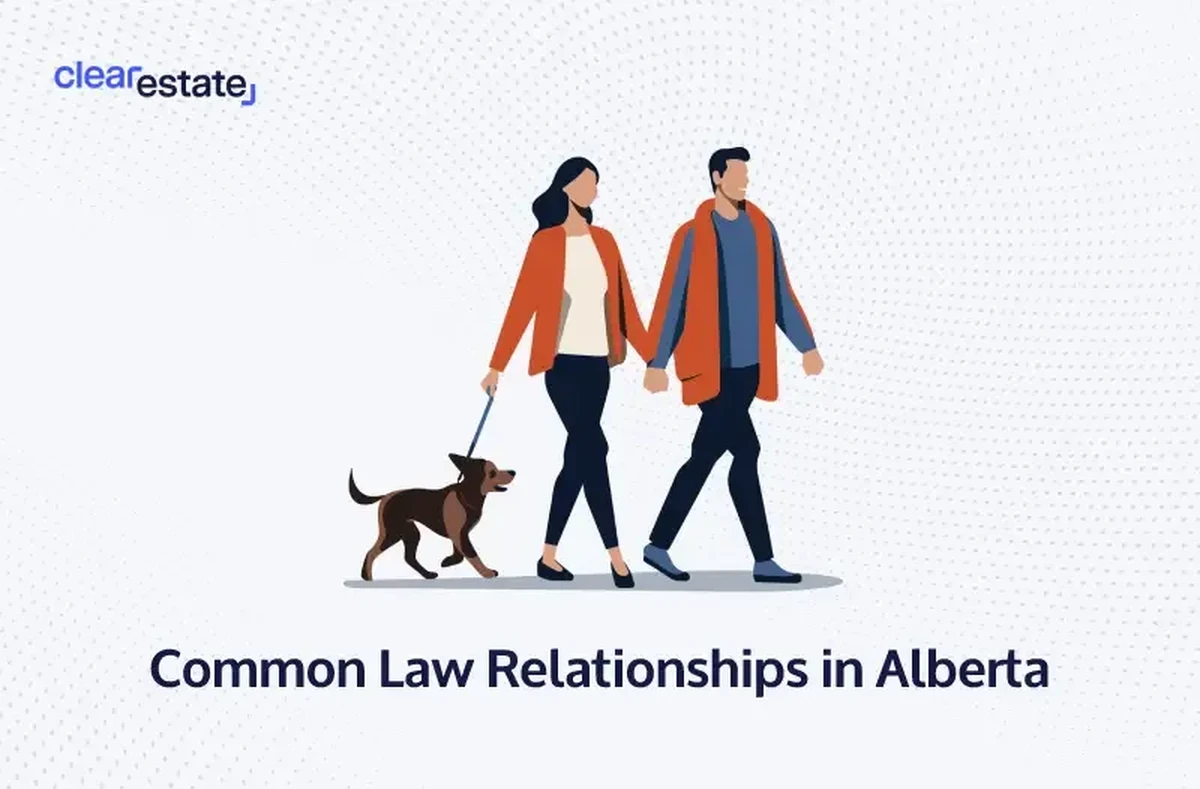Estate Planning
Oct 27, 2025
Introducing Empathy to Estate Bureaucracy
ClearEstate’s origin story: how grief, inefficiency, and compassion inspired Alex to build a fintech that brings empathy and efficiency to estate planning and settlement
Understand Alberta's common law partnerships: Navigate rights, responsibilities, and benefits under Adult Interdependent Partnership laws.


Since 2003, Alberta has switched out the term ‘common-law’ couple, and now instead refers to this kind of relationship as an ‘Adult Interdependent Partnership,’ or AIP for short. These unique relationships, distinct from traditional legal marriage, have an equally unique legal framework to prevent and solve complications that may arise, just like with other legally recognized relationships.
As found in the Adult Interdependent Relationship Act, a relationship may be considered as common law – now called AIP – when it meets certain criteria that qualify these two partners as being a single domestic unit. Relationships considered to be legally recognized as an AIP when the partners have lived with each other in an interdependent relationship under one or more of the following conditions:
While there is no official form to submit to gain legal recognition for an AIP relationship, there is a suggested format created by the province, written under the Adult Interdependent Partner Agreement Regulation. Following this template can help ensure that the written document is considered valid.
Also of note is that a relationship does not necessarily need to be romantic or conjugal in nature to classify as an AIP. Examples of partnerships that qualify include platonic relationships, family members, and in some cases, minors. The distinction is made as long as both individuals are functioning together as a single domestic and economic unit, sharing assets and responsibilities, and ultimately, are emotionally committed to sharing their lives.
There are also designated criteria for when a relationship cannot be considered a valid AIP. If any of the following apply, the relationship will automatically not be considered an adult interdependent relationship:
If two partners acting as a single economic and domestic entity do not meet the criteria to be considered an adult interdependent partnership under provincial law, they may still be considered common-law partners under federal law. It’s always best to consult with a legal professional to determine the exact legal implications of a relationship, and what the partnership may qualify as.
Partners recognized as being in an adult interdependent relationship are protected by certain rights, and are entitled to receive the associated benefits that come with the relationship’s legal recognition.
Most notably, AIP partners are given similar rights and protections as to what a married couple would have. For this reason, proving that the relationship qualifies as an AIP is the first and arguably the most important step in ensuring that the couple’s rights are protected. Doing so will help avoid any legal disputes that may arise if the relationship doesn’t meet the legal criteria.
The rights of an AIP relationship are outlined in a handful of acts, including the Family Law Act. These include benefits relating to property division, insurance and taxation, inheritance, and the right to use the home after a partner passes away. This gives individuals in an AIP relationship legal recognition and thus protection, but only if they meet the legal criteria first.
The most significant legal implications of being in an AIP in Alberta include:
Understanding the legal significance of an adult interdependent partnership in Alberta is essential to help individuals in such a relationship navigate their rights and responsibilities effectively. It’s always a good idea to seek legal guidance to be sure that all nuances of the partnership are understood and documented in a legally binding way.
In Alberta, when an adult interdependent partnership ends, the two partners must navigate the separation process, in particular for matters related to property division and parental responsibilities. Knowing the process in advance is the easiest way to ensure a fair resolution for everyone involved.
It is important to know when the relationship is no longer considered an adult interdependent partnership. An AIP ends if:
With this in mind, there are several ways an AIP relationship may end, ranging from separation to a legal marriage. If the AIP is annulled because the relationship has ended and the partners are separating, then the partners have legal rights that protect them during the process of property division.
Firstly, if the relationship was legally recognized as an AIP, then the partners have a similar legal recognition to married couples. Because AIP relationships are legally recognized, laws concerning property division and rights apply, including any that apply to married spouses, such as the Assured Income for Severely Handicapped benefit, spousal or child support.
When it comes to actually dividing property during a separation, personal property and gifts are kept by the individual they belong to. The rest of the property is divided – not necessarily equally, but fairly – based on the situation of each partner, and the type of property in question.
Each partner keeps the property they personally brought into the relationship, as well as any personal property such as gifts, and the rest of the property is divided according to the
cohabitation agreement made. Or, if none was made, it is divided as per the Family Property Act.
Any property that is jointly owned is typically divided equally, unless a cohabitation agreement is in place that dictates an alternate plan for property division. When assessing property division, courts take into account what each partner contributed during the relationship to ensure that all property is divided fairly.
Another important aspect to consider in adult interdependent partnerships is which partner will be performing which domestic responsibilities. This is especially true when children are involved, and even more in the event of a separation. If an AIP couple separates and there is a child’s well-being to consider, the partners will still have certain responsibilities expected of them.
Both parents are required to provide financial support to their children. In Alberta, child support is determined for AIP couples the same as for married couples. This is done based on guidelines that consider the income of both partners and the number of children involved. Specifics relating to child support after a separation can also be determined in advance, when the partners draft the cohabitation agreement.
Parental custody and the time spent with each parent is another factor to consider, one that must be made with the child’s best interest in mind. This means considering the child’s relationship with each parent, as well as each parent’s ability to care for the child, and any other factors that might affect the child in question.
To avoid any disagreements escalating into legal disputes, it is important for the AIP couple to discuss their plan for dependents in advance and to legally formalize any agreements made about child support and custody. Planning these aspects beforehand will set clear expectations for everyone involved if a separation does occur. It can also play a large role in helping any children adjust to the changes associated with the separation.
 Secure Your Legacy
Secure Your Legacy
Get your free 12-step Estate Planning checklist now. 89% of readers complete their estate plan within 3 months of using our guide.
Instantly Access Now